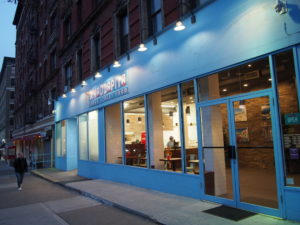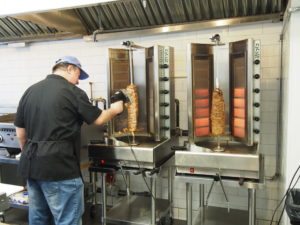Everything about Whaddapita is unlikely: The owner, 50-year-old Constantine Casvikes, has a background in construction, not restaurants. He picked a location that had been vacant for over three years, which might have been a risky move. And the second-generation Greek immigrant opened in central Harlem, instead of a traditionally Greek neighborhood like Astoria, Queens. Yet he was ready to add more dishes and more tables after only three months of serving traditional Greek food, while many new places are still struggling to stay afloat at that point.
He credits his success, so far, with the market research he did on his own. Last spring, Casvikes spent several days, both weekdays and weekends, walking around central Harlem. He sat at the cafe next to Whaddapita’s current location and observed people, walked down nearby streets checking out the restaurants and food trucks, and talked to people in nearby parks about what they liked to eat.
“There’s no Greek place around,” Casvikes said, “but people here like Greek food,” and a lot of them liked the idea of having a Greek restaurant here.
Harlem, at the northern section of Manhattan, has been known since the 1920s as a center of African American life — residential, cultural and business. It began to see rapid gentrification in the late 90s and is now one of the most racially and culturally diverse neighborhoods in the city.
The population of central Harlem grew from about 118,143 people in 2006 to about 143,487 in 2016. The Racial Diversity Index of central Harlem grew from 0.48 to 0.63, indicating a more racially diverse population, and the number of residents identified as black dropped from 69% to 53%, in that decade.
Casvikes had kept an eye on the changes in Harlem, especially during the past five years, though he never lived there. “This place is up and coming,” he said, with more families moving in, as well as single, young people. He finally chose the current place over a few more costly locations in midtown and downtown area.
“It’s a nice new place to come,” said Angelika Lava, a Belarus student at The City College of New York. “You don’t have many good options around.”
At around 4 p.m. on a Tuesday, customers filled most of the restaurant. Others came in, curious, to grab a menu. Casvikes stood behind the counter as a temporary cashier and waiter. A slight and taciturn man in his ink-blue sweater, he explained the menu concisely, served the food politely, and cleaned the tables in between taking phone orders and preparing free homemade Greek yogurt samples.

Constantine Casvikes (left), owner of Whaddapita, prepares free homemade Greek yogurt sample for a customer. Photo: Yuan Yuan.
Unlike Greek restaurants in a Greek neighborhood like Astoria, Queens, or upscale Greek restaurants with sophisticated dishes in midtown, Whaddapita offers fast, affordable and filling food—gyro and falafel, for examples.
“In Greece this kind of restaurant is known as a souvlaki shop. They have existed for centuries,” said Matt Barrett, a Greek American travel blogger who worked in restaurants for decades, in an email.
Souvlaki, a popular Greek fast food consisting of meat and sometimes vegetables grilled on a skewer, can be served with pita bread, fried potatoes, lemon, and sauces. Souvlaki can also be used as a replacement term for gyro, slices of roasted meat, often wrapped in a round pita bread along with tomato, onion, French fries and gyro sauce—tzatziki, a traditional Greek sauce with Greek yogurt, dills, cucumber, and a little lime juice.
“When I tell my old friends who used to live in Greece I am going there, they always ask me to bring them back a souvlaki. So you see, the power of the souvlaki is strong,” Barrett wrote in the Greece Travel Guide website he runs.
Casvikes’ parents immigrated to the city from Karpenisi, Greece, in the late 1950s, in search of a better life. His father got a job in a restaurant while his mother stayed at home.
Greeks of the second immigration wave, in the 1960s, were often involved in larger diners, which offer typical American fare along with Greek specialties, said Fevronia Soumakis, an adjunct assistant professor at Columbia University in history and education and an expert on Greek immigration in New York City.
Whaddapita represents a shift from those diners to more specialized Greek restaurants, including Greek quick-serve, she said.
Casvike’s brother, Pavlo, opened the first Whaddapita in Portland, Maine, in 2010, closed it in 2012 and opened a new Greek restaurant, Gourmaine, there.
Constantine went up to Portland to help at his brother’s former Whaddapita for six months before he decided to open one in New York City. But unlike his brother, who is a chef, Constantine never dreamed of going into food industry—he majored in political science but worked in construction for years. He is still not sure whether this new adventure, a restaurant, will be what he decides to do long-term.
Although the Casvikes brothers didn’t grow up near their father’s restaurant kitchen, magically, “the road just took us right here,” Constantine said.
Tags: central Harlem, Greek food, gyro, souvlaki shop, Whaddapita


Your Comments